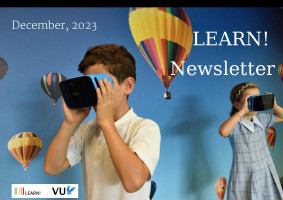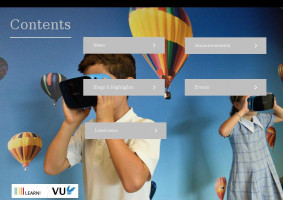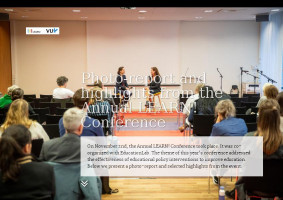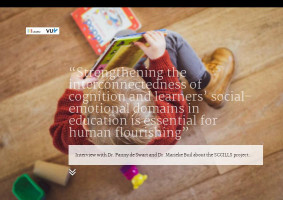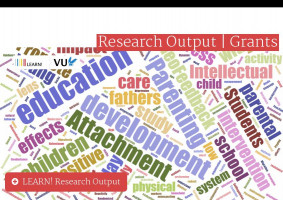Could you briefly describe what your project entails?
We develop the SCCILLS intervention for teachers in first- and second-grade of elementary schools, which is a psycho-education and video coaching intervention to enhance children’s Social Emotional Learning (SEL) competencies.
“SEL is the process through which children acquire and apply the knowledge, skills, and attitudes to develop healthy identities, manage emotions and achieve personal and collective goals, feel and show empathy for others, establish and maintain supportive relationships, and make responsible and caring decisions'' (CASEL, 2020).
SCCILLS improves SEL via 1) enhancing knowledge of teachers about SEL and how to stimulate SEL, 2) fostering healthy and positive teacher-child relationships and 3) stimulating responsive pedagogical strategies of teachers.
We expect that this will lead to not only improved SEL competencies of children, but also a reduction of emotional and behavioural problems. Furthermore, SCCILLS will lead to a more positive classroom atmosphere, and improve teacher efficacy and wellbeing.
SCCILLS consists of 3 team meetings for the whole school team, 4 individual meetings which are focused on enhancing the teacher-child relationship, and 2 video-intervision meetings which are focused on increasing responsive teaching.
At this time, the SCCILLS intervention development is almost finished. This academic year and next year we will collect the data. We will train videocoaches to apply SCCILLS at their schools. We will test SCCILLS in 28 classrooms, and include 28 control classrooms in our study.
What are the main aims of your project?
We aim to:Test whether SCCILLS improves SEL competencies, via increases in positive teacher-child relationships and responsiveness of teachers. Test whether SCCILLS via improving SEL, 1) reduces emotional and behavioural problems of students, 2) improves the classroom climate, and 3) enhances teacher wellbeing.
What is social emotional learning?
In addition to what was already mentioned, SEL competencies include 5 domains:
1) self awareness (e.g., recognizing your own emotions and knowing your talents)
2) self management (e.g., regulating your emotions, planning, and organisation skills)
3) social awareness (e.g., perspective taking, empathy),
4) relationship skills (e.g., building positive social relationships, resisting social pressure), and
5) responsible decision making (e.g., evaluating consequences of your actions). This last domain builds on the previous four domains.
The target group of your project are children attending the 3rd and 4th grade of elementary school. Why this group in particular? Why not younger/older children?
Ideally, a SEL-intervention is implemented throughout all years of elementary school to be most effective. Due to budget limitations and practical limitations, testing SCCILLS from kindergarten to sixth grade is not possible at this moment. We chose to focus on first and second grade teachers and students (Dutch 3rd and 4th grade), because SCCILLS at this developmental stage of children still has a preventative effect regarding the development of behavioural and emotional problems in children, which should be addressed as early as possible. Furthermore, SCCILLS builds upon a previously developed intervention program (Key-2-Teach) which was implemented and found to be effective in first and second grade in a previous research project. However, Key-2-Teach was focused on reducing behavioural problems of students only, while SCCILLS focuses on the full SEL spectrum.
You mentioned that the intervention would include psycho-education of teachers. Could you elaborate on that?
Psycho-education means that we provide teachers with knowledge about what SEL is, and how the relationship of the teacher with the student, as well as the pedagogical strategies of the teachers are related to children’s SEL. Teachers often do not precisely know what SEL is, and feel incompetent to address SEL. From previous studies we know that knowledge about SEL and how to improve SEL in students as a teacher is important for the effectiveness of SEL-interventions. Current programs do not provide teachers with tools on how they can improve SEL in their daily interactions with children in the classroom. Currently, programs often consist of weekly lessons for students, similar to maths or reading, but they do not include effective teacher practices and pedagogy.
What are the benefits of enhancing positive teacher-child relationships? Does it have an influence on childrens’ progress at school?
The teacher-child relationship the teacher experiences consists of the emotions and attitudes of teachers about a student and about the relationship with this student. These views are often coloured by previous experiences of teachers. This may be experiences the teacher had with this particular student (“X is angry again, he is not motivated just like last week”), with other students with similar problems (“this student behaves just like X last year”), or even hearing colleagues talk about a student during lunchtime. These quick interpretations are very handy, because they allow you to make quick decisions in complex situations such as the classroom. However, these views are also coloured and tend to become more rigid and inflexible, particularly under stress. Especially for students that have problems with SEL, who often experience challenges regarding emotional and behavioural problems, there is an increased risk of developing a negative relationship with their teacher.
Looking through this coloured lens, teachers are prone to focus on information that is in line with their prior views and disregard information that conflicts with their views. In practice this means that positive behaviour might be disregarded, while negative behaviour receives more attention and gets affirmed by the teacher. Thereby, the teacher-child relationship also shapes the interactions of the teacher with the student, and consequently affects the student’s behaviour. Conflict in the teacher-child relationship is related to increased behavioural problems, and problems with self-regulation. Furthermore, conflictual teacher child relationships are related to reduced engagement, cognitive functioning, and academic achievement. Reducing conflict and building warm teacher child relationships therefore is important for children’s emotional, behavioural, and academic development.
Therefore, an important component of SCCILLS is to address this coloured lens of teachers, by reflecting on the relationship and actively taking the perspective of students. This way, current views become more flexible, and teachers see students in a more favourable light. They become more effective in looking behind the behaviour of the student (so, “what does the student communicate/want to express with this behaviour?”). This improves teachers' sensitivity and sensitive responsivity to students, and they can better adapt to the students’ needs.
Could you give an example of an effective coaching method/approach?
We use different coaching methods with SCCILLS. We use a reflective instrument (BeGRP, Endedijk et al., 2023) to increase perspective taking of teachers. We also use video coaching. A coach films interactions in the classroom. These interactions are analysed on a micro-level together with the teacher. The focus is on positive interactions, and generalising these to other situations and other students. SCCILLS is an intervention with a schoolwide component, by including three team meetings. Schoolwide programs are more effective than individual programs.
You can read more about the SCCILLS project here: https://www.sccills.nl/

dr. Fanny de Swart
Assistant Professor, Faculty of Behavioural and Movement Sciences, Clinical Developmental Psychology
dr. Marieke Buil
Assistant Professor, Faculty of Behavioural and Movement Sciences, Clinical Developmental Psychology
